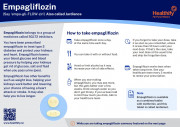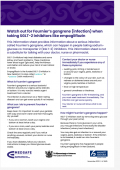Here are some things to know when you're taking empagliflozin. Other things may be important as well, so ask your healthcare provider what you should know about.
You are at increased risk of urinary tract or fungal genital infection (thrush)
Empagliflozin causes you to pee more and have more glucose in your urine, which increases your risk of getting urinary tract infection (UTI) or thrush (a fungal infection) around the vagina or penis. Germs (bacteria and fungus) like to grow in body fluids with a high sugar content. As your blood glucose level decreases, this tends to settle.
To reduce the risk of infection, wash your genital area (privates) with warm water using non-perfumed soap. Also any drops of pee left behind on your penis or vagina need to be removed.
- People with a vagina should wash their vulval area twice a day. Also, every time after peeing, rinse the area with water and then pat dry with toilet paper. If rinsing isn't possible, just pat dry carefully with toilet paper.
- People with a penis should wash their groin area at least once a day. Also, every time after peeing, rinse your penis with water and then pat dry with toilet paper. If rinsing isn't possible, just pat dry carefully with toilet paper. Pull back your foreskin before you pee, to avoid drops of urine spilling into the foreskin fold.
If you get any of the following symptoms, contact your healthcare provider immediately
- Pain or a burning sensation when peeing.
- The need to pee more often, suddenly or urgently than usual.
- Pee that looks cloudy, dark or has a smell.
- Lower tummy pain or pain in your back, just under your ribs.
- Irritation or itching, pain, redness or swelling in your genital area (privates) or around your bottom.
It's important to treat thrush or UTI early. If left untreated, it can turn into a serious life-threatening infection called Fournier’s gangrene(external link).
|
Have a sick day plan
If you're unwell, with vomiting, diarrhoea or a fever or you're not eating or drinking as usual, stop taking empagliflozin. Only restart empagliflozin when you are well AND you've been eating and drinking normally for 1 to 2 days.
- Taking empagliflozin when you're unwell increases your risk of high ketone levels, which can cause a serious side effect called ketoacidosis. Ketoacidosis causes your blood to become too acidic and can be very dangerous if it's not treated.
- This advice is the same whether you're taking empagliflozin for diabetes or heart failure.
|
If you have nausea (feeling sick), vomiting (being sick), pain in your tummy (puku) and feel unwell and confused:
- Stop taking empagliflozin, AND
- Go to your GP clinic, after hours medical centre or hospital straight away. You need to have a finger prick blood test immediately to check your ketone levels.
Ketoacidosis is very serious and needs immediate treatment.
|
Being dehydrated and not eating enough carbohydrates can cause serious side effects
Being dehydrated and not eating enough carbohydrates can lead to high ketone levels, which can cause a serious but rare side effect called ketoacidosis.
-
Tell your healthcare team before making any big changes to your diet: It's a good idea to cut down on foods with added sugar if you have diabetes. However, having too few carbohydrates in your diet while you're taking empagliflozin may increase your risk of ketoacidosis. Tell your healthcare team if you start eating less, go on a keto (low carbohydrate) diet or if you're fasting. Read more about empagliflozin, fasting and low carbohydrate diets(external link).
- Fasting during Ramadan: If you're fasting during Ramadan and are still getting enough carbohydrates, you can keep taking empagliflozin. It's important to talk to your healthcare provider about getting enough carbohydrates and drinking plenty of water while taking empagliflozin. It's not recommended to start empagliflozin as a new medicine immediately before or during Ramadan.
- Long-distance runners or cyclists: If you're going to run or cycle a long distance while you're taking empagliflozin, it's important to let your healthcare provider know. You may need to stop empagliflozin the day before the event and restart 24 hours or so afterwards when you are well hydrated and eating normally.
- Avoid or limit alcohol. Drinking too much or too often (binge drinking) can cause ketoacidosis.
Prepare before an operation or a procedure
If you are going to have an operation or a procedure where you will need to stop eating for 12 hours or more (eg, a colonoscopy or dental surgery), ask your healthcare team when you should stop and restart your empagliflozin. You may need to stop your empagliflozin 3 days before the operation or procedure.
Are you pregnant, trying for a baby or breastfeeding?
It is important to talk to your healthcare provider as soon as possible if you're trying to get pregnant, are pregnant (hapū) or breastfeeding. You may need to change to another medicine.
Tell your healthcare team if you are taking any other medicines
Empagliflozin may interact with some medicines and herbal supplements, so check with your prescriber or pharmacist before starting empagliflozin and before starting any new medicines or herbal supplements.









